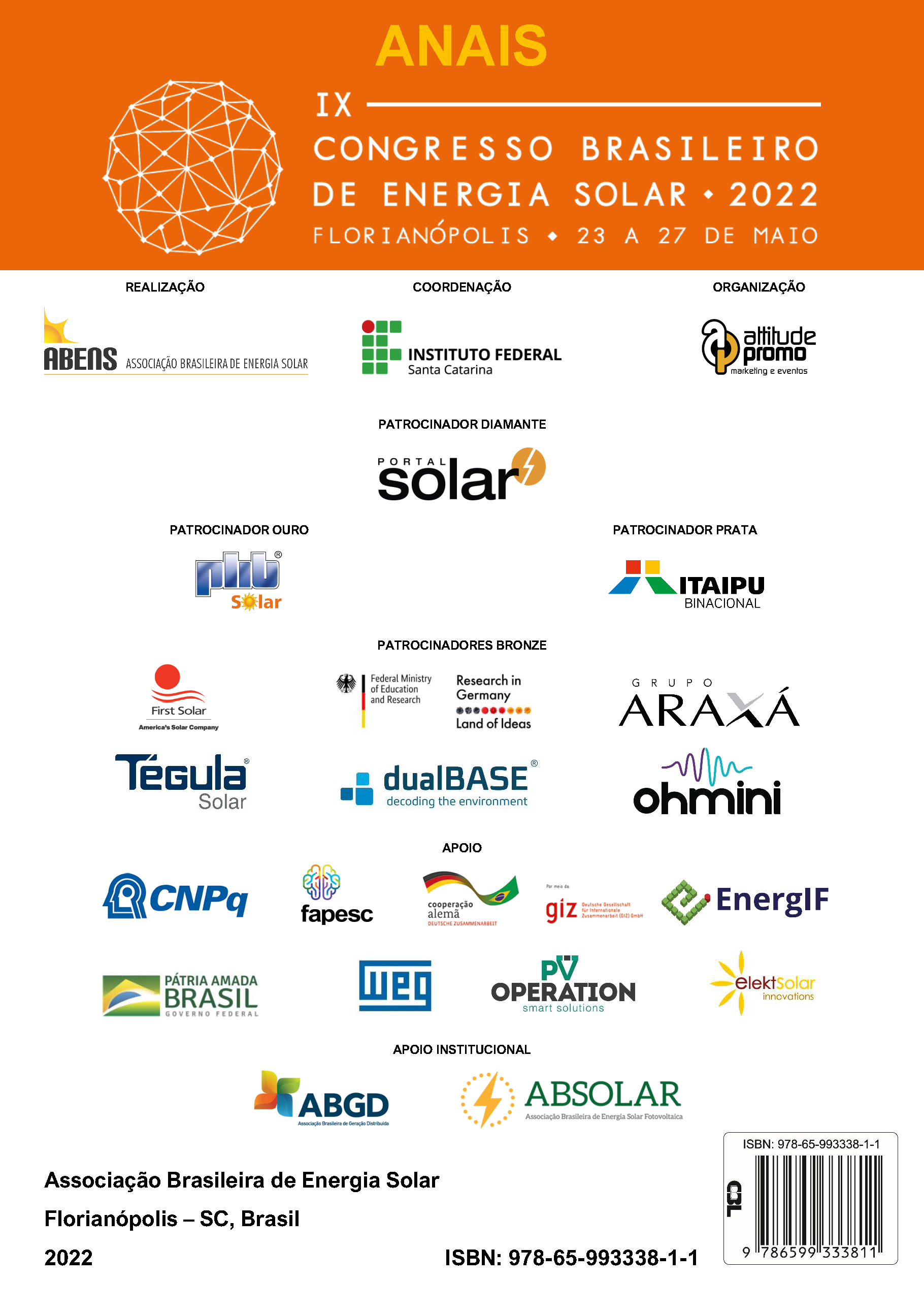ZINC OXIDE NANOSTRUCTURES TO INCREASE EFFICIENCY OF ORGANIC SOLAR CELLS
DOI:
https://doi.org/10.59627/cbens.2022.1111Keywords:
Nanoparticles, Zinc Oxide, Organic Solar CellAbstract
This work presents a new approach in exploring zinc oxide (ZnO) nanoparticles (NPs), aiming to improve the performance of on organic solar cells (OSC). ZnO nanoparticles dispersed on the top surface of the cell active layer can reduce the device reflection and increase the absorption of solar radiation in the photovoltaic active layer, acting as nano-diffusers and introducing an increase of the light path inside the device. In this work, optical and electrical modeling of photovoltaic cells with the insertion of ZnO NPs on top of the active layer are presented. Computer simulations, based on the finite element method, will be used to analyze the contribution of ZnO nanodiffusers in improving cell performance. ZnO nanoparticles will be synthesized by a green synthesis route and experimentally characterized. Results show that the use of ZnO NPs (160 nm in diameter) on the top surface of an organic solar cell can reduce the device reflectance by up to 95 % for λ = 530 nm, promoting efficient light coupling in the active layer of the cell and simultaneously increasing the absorbance (26 %) of the device. It was also verified that the contributions of “light trapping” and anti-reflective effect improve photocurrent generation, showing an increase in short-circuit current density.
Downloads
References
Notarianni, M., Vernona, K., Chou, A., Aljadab, M., Liu, J., Motta, N., 2013. Plasmonic effect of gold nanoparticles in organic solar cells. Solar Energy 106, 23-37.
NREL, Best Research Cell Efficiencies https://www.nrel.gov/pv/assets/images/efficiency-chart.png> (Acesso em 09.12.21).
Park, S., Tark, S. J., Lee, J. S., Lim, H., Kim, D., 2009. Effects of intrinsic ZnO buffer layer based on P3HT/PCBM organic solar cells with Al-doped ZnO electrode. Solar Energy Materials and Solar Cells, 93, 6–7, 1020-1023.
Phornano, Verdequant, Zinc Oxide. <https://www.phornano.com/verdequant> (Acesso em 15.05.21).
Piccinno, F., Gottschalk, F., Seeger, S., Nowack, B., 2012. Industrial production quantities and uses of ten engineered nanomaterials in Europe and the world. J Nanopart Res 14, 1109.
Pillai, S., Catchpole, K. R., Trupke, T., Green, M. A., 2007. Surface plasmon enhanced silicon solar cells. Journal of Applied Physics 101, 093105.
Ramya, M., Nideep, T.K., Nampoori, V.P.N., Kailasnath, M., 2021. The impact of ZnO nanoparticle size on the performance of photoanodes in DSSC and QDSSC: a comparative study. J Mater Sci: Mater Electron 32, 3167–3179.
Reynaud, C., Clerc, R., Lechene, P., Hebert, M., Cazier, A., Arias, A., 2019. Evaluation of indoor photovoltaic power production under directional and diffuse lighting conditions, Solar Energy Materials and Solar Cells, 200, 110010.
Rodrigues, E.S., Silva, M.S., Azevedo, W.M. Feitosa, S., Stingl, A., Farias, P. M. A., 2019. ZnO nanoparticles with tunable bandgap obtained by modified Pechini method. Appl. Phys. A 125, 504.
Scharber, M., Sariciftci, N., 2013. Efficiency of bulk-heterojunction organic solar cells. Progress in polymer Science 38.12, 1929-1940.
Senthilkumar, N., Arulraj, A., Nandhakumar, E., Ganapathy, M., Vimalan, M., Vetha Potheher, I., 2018. Green mediated synthesis of plasmonic nanoparticle (Ag) for antireflection coating in bare mono silicon solar cell. Journal of Materials Science: Materials in Electronics, 29(15), 12744–12753.
Shah, S.K., Khan, J., Ullah, I., Khan, Y., 2017. Optimization of activelayer thickness, top electrode and annealing temperature for polymeric solar cells. AIMS Materials Science 4(3), 789-799.
Shanmugam, N., Pugazhendhi, R., Madurai Elavarasan, R., Kasiviswanathan, P., Das, N., 2020. Anti-Reflective Coating Materials: A Holistic Review from PV Perspective. Energies 13, 2631.
Sharma, S., Tran, A., Nalamasu, O., Dutta, P. S., 2006. Spin-coated ZnO thin films using ZnO nano-colloid. Journal of Elec Materi 35, 1237–1240.
Spyropoulos, G. D., Stylianakis, M. M., Stratakis, E., Kymakis, E., 2012. Organic bulk heterojunction photovoltaic devices with surfactant-free Au nanoparticles embedded in the active layer. Applied Physics Letters 100, 213904.
Srivastava, A., Samajdar, D. P., Sharma, D., 2018. Plasmonic effect of diferente nanoarchitectures in the efficiency enhancement of polymer based solar cells: A review. Solar Energy 173, 905-919.
Stelling, C., Singh, C. R., Karg, M., K¨onig, T. A. F., Thelakkat, M., Retsch, M., 2017. Plasmonic nanomeshes: their ambivalent role as transparent electrodes in organic solar cells, Sci. Rep. 7, 42530.
Stevens, L., Hohn, O., Hanser, M., Tucher, N., Muller, C., Glunz, S., Blasi, B., 2021. Impact of the refractive index on coupling structures for silicon solar cells. J. Photon. Energy 11(2) 027001.
Stingl, A., Silva, M., Alves, V., Ayala, C., Rodrigues, E. Method of Producing a Metal Or Metal Oxide Nanoparticle (WO2021046586). 2021. https://worldwide.espacenet.com/patent/search/family/072355731/ publication/WO2021046586A1?q=phornano
Sun, C., Pan, F., Bin, H., Zhang, J., Xue, L., Qiu, B., Wei, Z., Zhang, Z., Li, Y., 2018. A low cost and high performance polymer donor material for polymer solar cells. Nat Commun 9, 743.
Tress W., 2014. Organic Solar Cells. In: Organic Solar Cells. Springer Series in Materials Science, vol 208. Springer, Cham. p. 139.
Wu, N., Luo, Q., Bao, Z., Lin, J., Li, Y., Ma, C., 2015. Zinc oxide: Conjugated polymer nanocomposite as cathode buffer layer for solution processed inverted organic solar cells. Solar Energy Materials and Solar Cells, 141, 248-259.
Yang, Z., Gao, P., Zhang, C., Li, X., Ye, J., 2016. Scattering effect of the highindex dielectric nanospheres for high performance hydrogenated amorphous silicon thin-film solar cells. Sci. Rep. 6, 30503.
Yu, X., Yu, X., Zhang, J., Zhang, D., Chen, L., Long, Y., 2017. Lighttrapping Al-doped ZnO thin films for organic solar cells. Solar Energy, 153, 96-103.
Zhang, T., Iqbal, S., Zhang, X., Wu, W., Su, D., Zhou, H., 2020. Recent advances in highly efficient organic-silicon hybrid solar cells. Solar Energy Materials and Solar Cells 204, 110245.
Znajdek, K., Sibinski, M., Lisik, Z., Apostoluk, A., Zhu, Y., Masenelli, B., Sedzicki, P., 2017. Zinc oxide nanoparticles for improvement of thin film photovoltaic structures’ efficiency through down shifting conversion. Opto-Electronics Review, 25, 2, 99-102.


